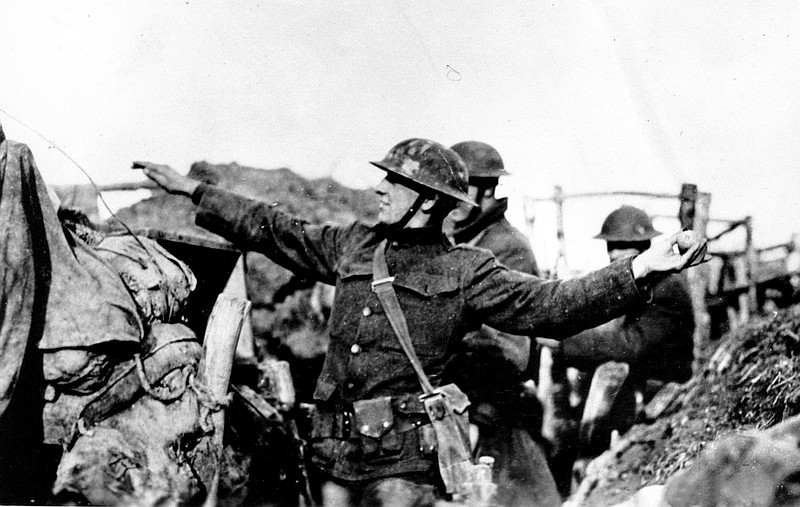See For Yourself
Through the Tennessee Virtual Archive, you can find out more about Tennesseans in World War I (http://sos.tn.gov/tsla/OverHere_WWI) and the Gold Star service records of 1,169 Tennessee soldiers in the conflict (http://bit.ly/TNGoldStar).
One hundred years ago last month, the United States entered what we know today as World War I.
No veteran of that war is alive, and few people if any are around who can provide even a first-person account of what things were like on the battlefield or the home front.
So as we prepare to mark Memorial Day tomorrow, we seem consigned only to read about and imagine the horrible scenes from what became known after its conclusion a little more than a year and a half later as the Great War or the War to End All Wars.
Fortunately, the Tennessee State Library and Archives has allowed us to do more than that and to do it from the comfort of wherever we can access the internet.
Ironic, isn't it? We can peruse the artifacts of war from the comfort of our couches. Yet, such examinations often can be instructive. It's history to learn, after all, and lessons not to repeat.
On the library's website is the digital archive "Over Here, Over There: Tennesseans in the First World War." There you can find photos of equipment carried by soldiers, postcards sent home, letters hurriedly written from the front, medals and much more.
With a mouse-click, you can be transported along with the Tennesseans who were there to the Argonne Forest, Orches, France, and Esch-Alzette, Luxembourg.
Digitally displayed, for example, are Pvt. Joseph W. Knox's shaving kit, the 1918 Christmas Day menu from the U.S.S. Minnesota, Pvt. Thomas Cleve Maness's mess kit, a trench knife and scabbard, Dennis E. Kearney's overcoat button, Pvt. Robert William Scollon's dog tags, Milton Calliham's New Testament, and Lawrence Ray Estep's enlistment and discharge record.
More haunting, though, are the letters. One from Pvt. John F. Blair of Nashville describes the terror of being shelled, and it is transcribed here as he wrote it.
"The country at this place was perferated with dugouts made by the enemy. I sought refuge in one. Shells still closing in on me, I decided the hole ajacent to mine would perhaps afford greater protection, so I rolled over into it.
"I had not more than got straightened out and my gun placed along side my face, for protection, until a big shell droped into the hole I had just left.
"Every thing turned darke for me. I gained consciousness when a sergeant came along checking up, and remarked to his buddy, 'There's one they got'."
Fortunately, Blair escaped with only a shrapnel wound in his right thigh.
Marine Jeff Montgomery of Jackson, Tenn., wrote to Ruth Hopper about the war's other scourge - the flu.
"It sure liked to have done me up Thursday night," he penned. "I don't believe that any one suffered any more than I did that night, but I didn't have any doctor as I never had sense enough to wake anybody up."
Sgt. Carl Cecil Braden of Nashville, while waiting to return home from Europe, described the terror of war to his mother.
" when you live 6 months on the front you have lived 5 years any where else," he wrote. "But it's all over now and I'll soon be back home and begin all over again at something somewhere."
Former British Prime Minister Winston Churchill, a battalion commander during the war, also described the conflict in "The World Crisis, 1911-1918."
"The Great War differed from all ancient wars in the immense power of the combatants and their fearful agencies of destruction," he wrote, "and from all modern wars in the utter ruthlessness with which it was fought."
Thus, it is not surprising that elsewhere in the digital archive is the Tennessee World War I Gold Star Records, which offers letters, clippings and military correspondence on soldiers from the Volunteer State who died in service to their country during the war (and whose relatives supplied the archive with material).
Among the Chattanoogans listed are druggist Frank Henry Cooper (not related to this editor), 21, who died of pneumonia in France in 1919 likely while awaiting transfer back to the United States; John Hooper Dayton, 18, who, "anxious to do his part," was working in an Oakdale, Pa., chemical company making explosives for the war effort when he "was totally destroyed in an explosion"; George Dillard, 25, who was killed in action a day before his birthday in Bellicourt, France, and is buried in the Chattanooga National Cemetery; Clifford Baxter Grayson, 24, who died a day after sustaining wounds at Vierzy, France, and was buried there; and Edwin Stanton Hale Jr., 22, a machine gunner who was killed in St. Souplet, France.
Today, the aforementioned are just names on tombstones and images on brittle photos in family scrapbooks. But each one did his part to keep the country free. Then, it was hoped the war in which they participated would be the war to end all wars. Today, we still hope the same for those who serve.
On Memorial Day, it costs us nothing to remember their sacrifice.
